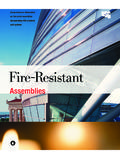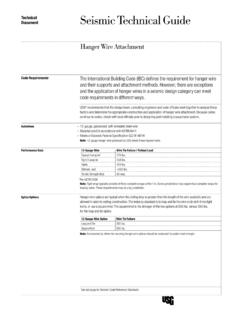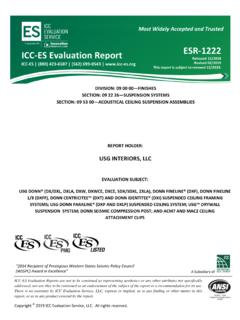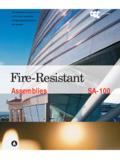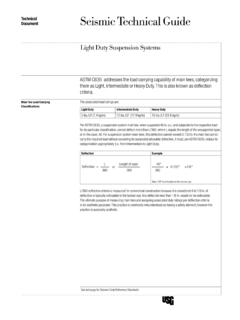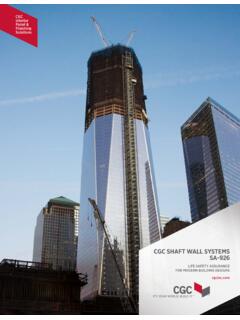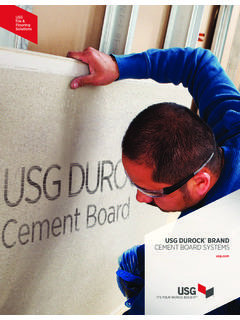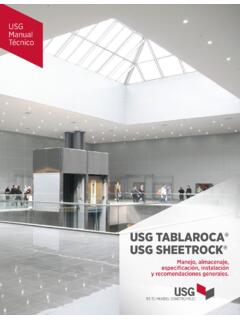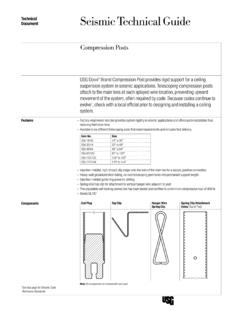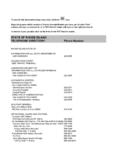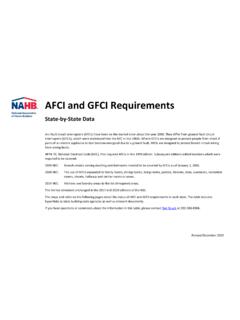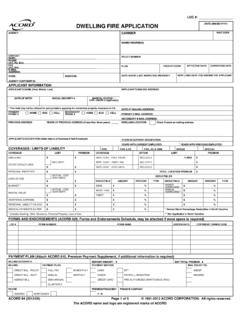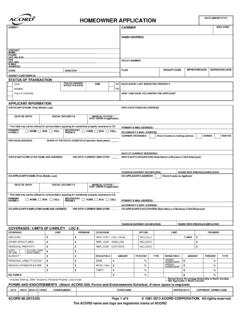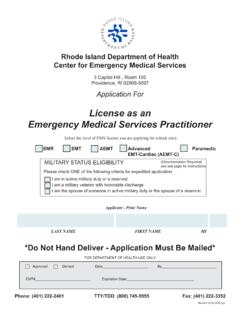Transcription of SAFETY DATA SHEET - USG
1 SAFETY DATA SHEET1. IdentificationSHEETROCK Brand Acoustical SealantProduct identifierOther means of identification61000040001 ASDS numberSound Blocking SealantSynonymsInterior useUse in accordance with manufacturer's restrictionsManufacturer/Importer/Suppli er/Distributor informationUnited States Gypsum CompanyCompany name550 West Adams StreetAddressChicago, Illinois phone number2. Hazard(s) identificationNot hazardsNot hazardsNot defined hazardsLabel symbolSignal statementPreventionObserve good industrial hygiene medical attention/advice if you feel as indicated in Section of in accordance with local, state, and federal (s) not otherwiseclassified (HNOC)None Composition/information on ingredientsMixtures471-34-1> 50 Calcium carbonate, syntheticCAS number%Chemical name56-81-5< 5 GlycerolAll concentrations are in percent by comments4. First-aid measuresProduct cannot be inhaled because it is a paste.
2 When dried, it does not require area with plenty of water. Get medical attention if irritation develops and contactDirect contact with eyes may cause temporary irritation. Flush thoroughly with water. If irritationoccurs, get medical contactRinse mouth. Get medical attention if any discomfort Brand Acoustical SealantSDS US930857 Version #: 03 Revision date: 28-October-2020 Issue date: 29-October-20151 / 7 Direct contact with eyes may cause temporary importantsymptoms/effects, acute anddelayedProvide general supportive measures and treat of immediatemedical attention and specialtreatment neededEnsure that medical personnel are aware of the material(s) information5. Fire-fighting measuresUse fire-extinguishing media appropriate for surrounding extinguishing mediaNot extinguishingmediaNot a fire hazards arising fromthe chemicalSelection of respiratory protection for firefighting: follow the general fire precautions indicated inthe workplace.
3 Self-contained breathing apparatus and full protective clothing must be worn incase of protective equipmentand precautions for firefightersUse standard firefighting procedures and consider the hazards of other involved fightingequipment/instructionsCool material exposed to heat with water spray and remove it if no risk is methodsNo unusual fire or explosion hazards fire hazards6. Accidental release measuresFor personal protection, see Section 8 of the precautions,protective equipment andemergency proceduresLarge Spills: Scoop spilled materials and recover as much of the product as possible for use. Ifspillage is unrecoverable dispose according to local, state, and federal Spills: Wipe up with absorbent material ( cloth, fleece). Clean surface thoroughly toremove residual and materials forcontainment and cleaning upAvoid discharge to drains, sewers, and other water precautions7. Handling and storageIn case of insufficient ventilation, wear suitable respiratory equipment.
4 Observe good industrialhygiene practices. Use proper lifting for safe handlingStore in a cool, dry, well-ventilated place. Store in a closed container away from incompatiblematerials. Protect from moisture. Keep away from heat. Do not use if material has spoiled, ,there is a moldy appearance or an unpleasant odor. Keep containers closed when not in gallon pails of sealant may be stacked a maximum of 3 layers high on a standard 48 x 48pallet (16 pails per layer, 3 layers high). Pallets may only be stacked a maximum of two for safe storage,including any incompatibilities8. Exposure controls/personal protectionOccupational exposure limitsUS. OSHA Table Z-1 Limits for Air Contaminants (29 CFR )FormValueComponentsTypePEL5 mg/m3 Respirable (CAS 56-81-5)15 mg/m3 Total NIOSH: Pocket Guide to Chemical HazardsFormValueComponentsTypeTWA5 carbonate,synthetic (CAS 471-34-1)10 mg/m3 TotalNo biological exposure limits noted for the ingredient(s).
5 Biological limit valuesProvide sufficient ventilation for operations causing dust formation. Observe occupationalexposure limits and minimize the risk of engineeringcontrolsIndividual protection measures, such as personal protective equipmentWear approved SAFETY protectionSHEETROCK Brand Acoustical SealantSDS US930857 Version #: 03 Revision date: 28-October-2020 Issue date: 29-October-20152 / 7 Skin protectionIt is a good industrial hygiene practice to minimize skin contact. For prolonged or repeated skincontact use suitable protective protectionSkin protectionNormal work clothing (long sleeved shirts and long pants) is engineering controls do not maintain airborne concentrations below recommended exposurelimits (where applicable) or to an acceptable level (in countries where exposure limits have notbeen established), an approved respirator must be worn. Use a NIOSH/MSHA approved airpurifying respirator as needed to control exposure.
6 Consult with respirator manufacturer todetermine respirator selection, use, and limitations. Use positive pressure, air-supplied respiratorfor uncontrolled releases or when air purifying respirator limitations may be exceeded. Followrespirator protection program requirements (OSHA and ANSI ) for all hazardsAlways observe good personal hygiene measures, such as washing after handling the materialand before eating, drinking, and/or smoking. Routinely wash work clothing and protectiveequipment separately from regular wash. Observe any medical surveillance hygieneconsiderations9. Physical and chemical thresholdNot - 10 Melting point/freezing pointNot boiling point and boilingrangeNot pointNot rateNot (solid, gas)Upper/lower flammability or explosive limitsFlammability limit - lower(%)Not limit - upper(%)Not limit - lower (%)Not limit - upper (%)Not pressureNot densityNot (H2O=1)Solubility(ies)Solubility (water)Miscible with coefficient(n-octanol/water)Not temperatureNot temperatureNot informationBulk lb/galNot propertiesNot propertiesVOC4 g/lSHEETROCK Brand Acoustical SealantSDS US930857 Version #: 03 Revision date: 28-October-2020 Issue date: 29-October-20153 / 710.
7 Stability and reactivityThe product is stable and non-reactive under normal conditions of use, storage and is stable under normal stabilityHazardous polymerization does not of hazardousreactionsNone to avoidNone materialsAbove 1472 F (800 C) limestone (CaCO3) can decompose to lime (CaO) and release carbondioxide (CO2).Hazardous decompositionproducts11. Toxicological informationInformation on likely routes of exposureInhalationNot relevant, due to the form of the contactMay cause allergic skin reactions especially in individuals with pre-existing skin disease such aseczema. (See Section 16).Eye contactDirect contact with eyes may cause temporary cause discomfort if related to thephysical, chemical andtoxicological characteristicsDust may irritate eyes and mucous membranes of the nose, throat and upper respiratory systemcausing sneezing and/or on toxicological effectsAcute toxicityNot expected to be a hazard under normal conditions of intended ResultsComponentsSpeciesCalcium carbonate, synthetic (CAS 471-34-1)OralAcuteLD50 Rat6450 mg/kgGlycerol (CAS 56-81-5)DermalAcuteLD50 Rabbit> 18700 mg/kgOralLD50 Rat27200 mg/kgProlonged or repeated skin contact may cause drying, cracking, or corrosion/irritationDirect contact with eyes may cause temporary eye damage/eyeirritationRespiratory or skin sensitizationRespiratory sensitizationNot a respiratory product contains a small amount of sensitizing substance which may provoke an allergicreaction among sensitive individuals after repeated contact.
8 For detailed information, see sensitizationData does not suggest that this product or any components present at greater than aremutagenic or cell mutagenicityCarcinogenicityThis product is not considered to be a carcinogen by IARC, ACGIH, NTP, or Monographs. Overall Evaluation of CarcinogenicityNot Report on CarcinogensNot Specifically Regulated Substances (29 CFR )Not product is not expected to cause reproductive or developmental toxicitySpecific target organ toxicity -single exposureNo data available, but none Brand Acoustical SealantSDS US930857 Version #: 03 Revision date: 28-October-2020 Issue date: 29-October-20154 / 7 Specific target organ toxicity -repeated exposureNo data available, but none hazardNot an aspiration effectsMay cause allergic skin disorders in sensitive individuals. For detailed information, see section Ecological informationThe product is not classified as environmentally hazardous.
9 However, this does not exclude thepossibility that large or frequent spills can have a harmful or damaging effect on the ResultsSpeciesCalcium carbonate, synthetic (CAS 471-34-1)AquaticAcuteLC50 Fish> 56000 mg/l, 96 HoursWestern mosquitofish (Gambusia affinis)Glycerol (CAS 56-81-5)AquaticAcuteEC50 Crustacea> 10000 mg/l, 24 HoursDaphnia magnaNo data and degradabilityBioaccumulation is not potentialPartition coefficient n-octanol / water (log Kow)Glycerol (CAS 56-81-5) data in soilOther adverse effectsNone Disposal considerationsDispose in accordance with applicable federal, state, and local regulations. Recycle instructionsDispose of in accordance with local disposal regulationsNot waste codeDispose of in accordance with local from residues / unusedproductsDispose of in accordance with local packaging14. Transport informationDOTNot regulated as dangerous regulated as dangerous regulated as dangerous in bulk according toAnnex II of MARPOL 73/78 andthe IBC Code15.
10 Regulatory informationThis product is not known to be a "Hazardous Chemical" as defined by the OSHA HazardCommunication Standard, 29 CFR components of this product are in compliance with the listing Requirements of the ToxicSubstances Control Act (TSCA) Chemical Substance federal regulationsTSCA Section 12(b) Export Notification (40 CFR 707, Subpt. D)Not Hazardous Substance List (40 CFR )Not 304 Emergency release notificationNot Brand Acoustical SealantSDS US930857 Version #: 03 Revision date: 28-October-2020 Issue date: 29-October-20155 / 7 OSHA Specifically Regulated Substances (29 CFR )Not 302 Extremely hazardous substanceSuperfund Amendments and Reauthorization Act of 1986 (SARA)Not 311/312 HazardouschemicalSARA 313 (TRI reporting)Not federal regulationsClean Air Act (CAA) Section 112 Hazardous Air Pollutants (HAPs) ListNot Air Act (CAA) Section 112(r) Accidental Release Prevention (40 CFR )Not Drinking Water Act(SDWA)FEMA Priority Substances Respiratory Health and SAFETY in the Flavor Manufacturing WorkplaceGlycerol (CAS 56-81-5)Other Flavoring Substances with OSHA PEL'sUS state regulationsUS.

